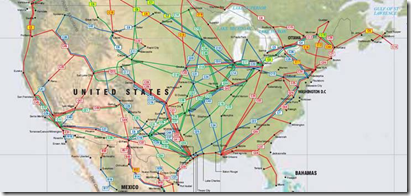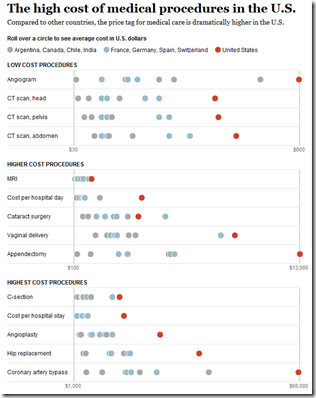US Economy Archive:
Federal Debt (1790-2037)
In: Maps Politics US Economy
1 Nov 2012From the generally impartial Pew Center:
Increase in federal support to states during recession:

Where the federal grant money went as percent of state revenue:
Update: Economic Indicators Dashboard
24 Sep 2012One of my favorite economic dashboards. It highlights major macro indicators, what direction they are trending, what the typical ranges are, and lets you drill down to explanations of why you should care. Looks like a lot of indicators are finally in the “typical” range.
The American Dream
In: Culture US Economy
24 Sep 2012Who Pays for Health Care (1960-2010)
In: Employment US Economy
18 Sep 2012Interactive graph of where the money comes from to pay medical bills (private insurance, medicare, out of pocket, etc). It’s interesting that private insurance still only covers a small amount of total expenses (~39%).
Drought (1896-2012)
In: Food History Maps US Economy
24 Jul 2012A look at drought through the years. There’s also a nice article about the design decisions and process that went into it.
America Revealed
In: Maps US Economy Video
20 Jun 2012Prepared for a PBS-UK television show (also available on DVD), these visualizations are stunning:
Here’s a preview of the show:
Rent vs Buy
4 Jun 2012The debate over whether it’s cheaper to rent or buy a house is complicated (where you buy, down payment, size of house, etc). But looking at median prices across the nation and current insanely low mortgage rates can make now look like the best time in a while to buy. Read the comment thread on the linked blog if you want more nuance.
If you want even more nuance, particularly if you’re buying a house as an investment, I recommend Barry Ritholtz’s 5 part article Debunking the Housing Recovery Story.
50 Years of Government Spending
In: Politics US Economy
18 May 2012I usually don’t like viewing stacked bars over time – it’s too hard to see what’s changing. This one still isn’t perfect, but the deficiencies are moderated somewhat by clear labels and only having the three columns. Content wise, it’s pretty fascinating too.
Why Gas Prices Vary Across the USA
In: Maps US Economy
23 Mar 2012James Hamilton takes a crack at explaining why gasoline prices vary so much across the country. I think he’s right that taxes, regulations, and transportation explain most of it, but I suspect that refinery shenanigans also play a role. Brad Plumer over at WashPost has additional insights.

(the original version of this map over at Gasbuddy is fun to zoom around in)
Update: Economic Indicators Dashboard
23 Mar 2012One of my favorite economic dashboards. It highlights major macro indicators, what direction they are trending, what the typical ranges are, and lets you drill down to explanations of why you should care about these numbers.
Ryan’s New Budget
21 Mar 2012There’s are a lot of nonsense charts and projections in Paul Ryan’s new House Republican budget, but rather than get into political arguments, I’ll just post the ones I thought were actually insightful:
High Costs of US Medical Procedures
In: Science US Economy
6 Mar 2012A recent study compared the cost of procedures across different countries. It’s interesting to me that some people think our “free market” medical system is the best, without realizing that health care services here in no way resemble a market. The related article runs through a number of ways our system is dysfunctional.
A wonderful post over at The Big Picture that takes both liberals and conservatives to the wood shed over their abuse of economic indicators and charts that show correlation but not causation.
Note: The comments over there are worth a read as well.
Update: Economic Indicators Dashboard
23 Jan 2012Updated for January: one of my favorite economic dashboards. It highlights major macro indicators, what direction they are trending, what the typical ranges are, and lets you drill down to explanations of why you should care. In other words, it’s a very sleek example of how to graph snapshot data while still providing valuable context.
What is Chart Porn?
An addictive collection of beautiful charts, graphs, maps, and interactive data visualization toys -- on topics from around the world.
Categories
- Bailout (118)
- Chartporn Related (3)
- Commentary (21)
- Culture (669)
- Emerging Markets (66)
- Employment (245)
- Environment/weather (133)
- Finance (298)
- Food (92)
- Global Economy (373)
- Graphic Design (bad) (26)
- Graphic Design (general) (183)
- Graphic Tools (23)
- History (158)
- Housing (162)
- Humor (204)
- Innovative (183)
- Interactive (545)
- Internet/tech (97)
- Maps (578)
- News Media (34)
- Politics (329)
- Reference (97)
- Science (331)
- Source: Economist (101)
- Source: FT (92)
- Source: NYT (147)
- Source: Ritholtz (76)
- Source: USA Today (27)
- Source: Washington Post (90)
- Source: WSJ (135)
- Sports (58)
- Stock Market (74)
- Uncategorized (2)
- Updated regularly (76)
- US Economy (553)
- Video (22)
- Aram Korevaar: This chart is now being used as a projection in which countries such as China see themselves as in a [...]
- David: Welcome back Chart Porn! [...]
- J S: Thanks for the great story. Miss reading this blog. Hope to see you more active again. [...]
- jake: I lived in a DC row house for 6 years, and I'm writing this comment from my tiny 1 bedroom apartment [...]
- ronny pettersen: Hilarious and unfortunately accurate... ;-) [...]

































